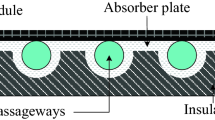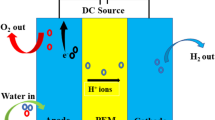Abstract
In this paper, the main aim is the performances modelling from the electrical and thermal point of view of a concentrating photovoltaic and thermal (CPV/T) system in order to evaluate the primary energy and economic savings respect to a traditional system, when the same energy loads are satisfied. This study is realized by both varying the CPV/T system configuration and considering two different users. In particular, the point-focus (PF), and linear focus (LF) configurations of the CPV/T system are considered in order to match the residential user and hotel energy loads. The CPV/T system is sized adopting as input data: the Direct Normal Irradiance (DNI) modelled by an artificial neural network and the users’ energy demands. In these hypotheses, the performances of the PF and LF systems are evaluated and then compared for the two users located in Southern Italy, in terms of electrical and thermal energy production, cells number, space occupied, energy and economic savings and CO2 emissions avoided. Finally, the PF system shows a lower simple pay-back and a higher primary energy saving, while the space occupied by a LF system results to be lower respect to the PF configuration.
Similar content being viewed by others
References
Sueyoshi T., Goto M., Photovoltaic power stations in Germany and the United States: a comparative study by data envelopment analysis. Energy Economics, 2014, 42: 271–288.
Renno C., Petito F., Triple-junction cell temperature evaluation in a CPV system by means of a Random- Forest model. Energy Conversion and Management, 2018, 169: 124–136.
Daneshazariana R., Cuceb E., Cuceb P.M., Sherc F., Concentrating photovoltaic thermal (CPVT) collectors and systems: Theory, performance assessment and applications. Renewable and Sustainable Energy Reviews, 2018, 81: 473–492.
Burhan M., Shahzad M.W., Kim Choon Ng., Long-term performance potential of concentrated photovoltaic (CPV) systems. Energy Conversion and Management, 2017, 148: 90–99.
Rajendran D.R., Ganapathy Sundaram E., Jawahar P., Experimental studies on the thermal performance of a parabolic dish solar receiver with the heat transfer fluids SiC plus water nano fluid and water. Journal of Thermal Science, 2017, 26: 263–272.
Sun J., Wang R., Hong H., Liu Q., An optimized tracking strategy for small-scale double-axis parabolic trough collector. Applied Thermal Engineering, 2017, 112: 1408–1420.
Benabderrahmane A., Aminallah M., Laouedj S., Benazza A., Solano J.P., Heat transfer enhancement in a parabolic trough solar receiver using longitudinal fins and nanofluids. Journal of Thermal Science, 2016, 25: 410–419.
Burhan M., Chua K.J.E., Kim Choon Ng., Sunlight to hydrogen conversion: Design optimization and energy management of concentrated photovoltaic (CPV-Hydrogen) system using micro genetic algorithm. Energy, 2016, 99: 115–128.
Sun J., Hong H., Liu Q., Numerical study of parabolictrough direct steam generation loop in recirculation mode: Characteristics, performance and general operation strategy. Energy Conversion and Management, 2015, 96: 287–302.
Burhan M., Shahzad M.W., Kim Choon Ng., Develpoment of performance model and optimization strategy for standalone operation of CPV-hydrogen system utilizing multi-junction solar cell. Journal of Hydrogen Energy, 2017, 42: 26789–26803.
Burhan M., Chua K.J.E., Kim Choon Ng., Simulation and develpoment of a multi-leg homogenizer concentrating assembly for concentrated photovoltaic (CPV) system with electrical rating analysis. Energy Conversion and Management, 2016, 116: 58–71.
Renno C., Optimization of a concentrating photovoltaic thermal (CPV/T) system used for a domestic application. Applied Thermal Engineering, 2014, 67: 396–408.
Ceylan I., Gurel A.E., Ergun A., Tabak A., Performance analysis of a concentrated photovoltaic and thermal system. Solar Energy, 2016, 129: 217–223.
Renno C., Petito F., Accarino M.L., Thermal model in ANSYS for a comparison between two configurations of a concentrating photovoltaic system. Heat Transfer Engineering. In print and published online March 22, 2018 DOI: 10.1080/01457632.2018.1446874.
Rodrigo P., Fernández E.F., Almonacid F., Pérez-Higueras P.J., Review of methods for the calculation of cell temperature in high concentration photovoltaic modules for electrical characterization. Renewable and Sustainable Energy Reviews, 2014, 38: 478–488.
Jakhar S., Soni M.S., Gakkhar N., Historical and recent development of concentrating photovoltaic cooling technologies. Renewable and Sustainable Energy Reviews, 2016, 60: 41–59.
Junction Solar Cell for Terrestrial Applications. CTJ photovoltaic cell 5.5 mm × 5.5 mm, Alhambra (United States), Emcore Corporation, Datasheets Emcore, https://assets.componentsense.com/images/pdfs/89821_2_7da3431c2dc0e81925db4c73523bf624.pdf, September 2012 (accessed on 3 June 2018)
Renno C., Petito F., Gatto A., ANN model for predicting the direct normal irradiance and the global radiation for a solar application to a residential building. Journal of Cleaner Production, 2016, 35: 1298–1316.
Luque A., Sala G., Arboiro J.C., Electric and thermal model for non-uniformly illuminated concentration cells. Solar Energy Materials and Solar Cells, 1998, 51: 269–290.
Renno C., Landi G., Petito F., Neitzert H.C., Influence of a degraded triple-junction solar cell on the CPV system performances. Energy Conversion and Management, 2018, 160: 326–340.
Fernández E.F., Ferrer-Rodríguez J.P., Almonacid F., Pérez-Higueras P., Current-voltage dynamics of multijunction CPV modules under different irradiance levels. Solar Energy, 2017, 155: 39–50.
Steiner M.A., Geisz J.F., Friedman D.J., Olavarria W.J., Duda A., Moriarty T.E., Temperature-dependent measurements of an inverted metamorphic multijunction (IMM) solar cell, 37th IEEE Photovoltaic Specialists Conference, Seattle, USA, 2011. doi:10.1109/PVSC.2011.6186461
Aldossarya A., Algaruea A., Mahmouda S., AL-Dadaha R.K., Performance of multi junction photovoltaic cells with high concentration ratio. Energy Procedia, 2014, 61: 2258–2261.
Aprea C., Renno C., An air cooled tube-fin evaporator model for an exsion valve control law. Mathematical and Computer Modelling, 1999, 30: 135–146.
Menconi A. Cogeneration in a hotel, Thesis, University of Pisa, Italy, 2004.
Renno C., Petito F., Choice model for a modular configuration of a point-focus CPV/T system. Energy and Buildings, 2015, 92: 55–66.
Renno C., Petito F., Experimental and theoretical model of a concentrating photovoltaic and thermal system. Energy Conversion and Management, 2016, 126: 516–525.
Sherif R., King R.R., Cotal H.L., Law D.C., Fetzer C.M., Edmondson K., Glenn G.S., Kinsey G., Krut D., Karam N.H., Concentrator triple-junction solar cells and receivers in point focus and dense array modules. In: 21st European PV Conference, 4–8 September, Dresden, 2006.
Author information
Authors and Affiliations
Corresponding author
Rights and permissions
About this article
Cite this article
Renno, C. Thermal and Electrical Modelling of a CPV/T System Varying Its Configuration. J. Therm. Sci. 28, 123–132 (2019). https://doi.org/10.1007/s11630-018-1082-4
Received:
Published:
Issue Date:
DOI: https://doi.org/10.1007/s11630-018-1082-4




